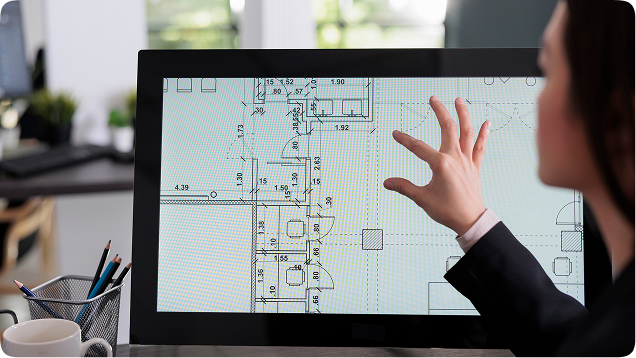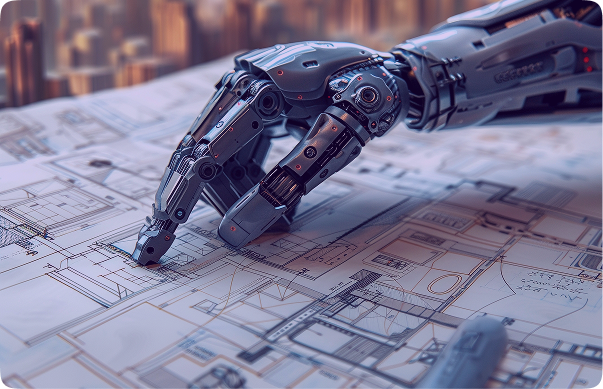Automating the Extraction of BOM/BOQ and Generating Rate Estimation

The Inefficiencies of Manual Extraction Processes
The manual derivation of the Bill of Materials from blueprints engenders several operational challenges. This approach is characterized by significant time expenditure, a propensity for human-induced errors, and potential inconsistencies arising from subjective interpretations. Design revisions further exacerbate the challenge of maintaining data accuracy, and the complexity inherent in contemporary designs amplifies these inherent difficulties. The necessity for specialized expertise, often subject to limited availability, necessitates resource-intensive efforts.
Moreover, the maintenance of comprehensive documentation and traceability imposes an additional burden on the process, thereby impacting project timelines and overall efficiency. These limitations underscore the imperative for more efficacious and error-minimized methodologies in Bill of Materials extraction, ensuring precision and reliability across diverse industrial applications.
The Integration of Machine Learning Technologies
Machine learning, a sophisticated domain within artificial intelligence, empowers computational systems to discern patterns and predict outcomes based on data analysis. Its integration into blueprint processing facilitates the automated extraction of Bill of Materials. This innovation serves to minimize human intervention and enhance the level of
precision achieved, representing a substantial advancement in project efficiency and data reliability.
Machine Learning Methodologies for Blueprint Analysis
Machine learning (ML) offers a refined approach to the analytical processing of blueprints. The key stages are outlined as follows:
- Data Preprocessing: The initial phase involves the preparation of data to facilitate subsequent analysis. Blueprint images are transformed into a format amenable to the ML model’s processing capabilities. Techniques such as image normalization and resizing are employed to optimize accuracy during subsequent analytical phases.
- Feature Extraction: This critical stage focuses on the identification of salient elements within the blueprint. Lines, geometric forms, and symbolic representations constitute the fundamental language of a blueprint. Convolutional Neural Networks (CNNs) demonstrate efficacy in the recognition of these features. Through the model training process, it learns to differentiate various components and patterns, establishing the groundwork for the accurate identification of parts and materials.
- Model Training: The core of ML efficacy resides in the training of the model. A labeled dataset comprising annotated blueprints serves as the foundational training data. Each blueprint functions as a labeled exemplar, wherein components have been pre-identified. By analyzing these exemplars, the model develops the capacity to associate specific visual features with their corresponding components, progressively refining its ability to accurately identify and categorize elements on novel blueprints.
- Testing and Validation: Subsequent to the training phase, the model undergoes rigorous testing utilizing previously unseen blueprints to evaluate its capacity for effective generalization. Validation protocols serve to fine-tune the model’s parameters and enhance its accuracy in the extraction of parts and materials lists from diverse blueprint formats.
- Integration with Existing Workflows: The final stage involves the seamless integration of the trained model into the established operational workflows utilized by engineering professionals. This integration ensures a fluid transition from blueprint analysis to the generation of parts and materials lists, thereby fostering a more efficient design and construction process.
A detailed examination of these steps provides a comprehensive understanding of how ML transcends a purely opaque mechanism to become a potent instrument for the transformation of blueprint analysis.

From BOM to Cost Estimates: Leveraging AI for Rate Calculation
Once the Bill of Materials is extracted using AI, estimating the project cost becomes easier. AI systems can match extracted components with predefined rate databases, supplier quotes, or market pricing APIs. This enables fast and consistent generation of cost estimates without manual lookup or calculations.
Here’s how it works:
- Mapping to Rate Data: Each item in the BOM is automatically matched to relevant pricing information from internal procurement records, ERP systems, or external data sources.
- Real-Time Updates: AI models can pull in updated pricing dynamically, reflecting changes in material costs or supplier rates.
- Scenario Simulation: Teams can run different pricing scenarios by adjusting quantities or switching materials to understand cost impacts instantly.
- Faster Bidding and Planning: With quick cost estimates available, project planning, budgeting, and client proposals can be created faster and with more confidence.
Integrating rate estimation into the BOM extraction process further enhances the value AI brings to engineering workflows, moving from data capture to informed financial decision-making.
The Advantages of AI Machine Learning
The integration of AI/ML into blueprint analysis yields significant enhancements in both efficiency and accuracy:
- Enhanced Workflow Efficiency: ML automates the analytical processing of blueprints, obviating the necessity for manual extraction of parts and materials lists. This automation results in a substantial reduction in processing time, thereby enabling professionals to allocate their expertise to more strategic and innovative facets of project execution.
- Minimization of Error: Human error represents an inherent variable in manual data extraction processes. ML algorithms, trained on extensive datasets, consistently apply predefined analytical rules. This meticulous approach significantly mitigates the risk of errors in the identification of parts and materials, leading to enhanced consistency and precision in construction endeavors.
- Optimization of Costs: Accurate data is fundamental to efficient procurement and project planning. ML-driven analysis minimizes inaccuracies in material selection, thereby preventing costly rework and project delays. This translates to substantial cost efficiencies throughout the project lifecycle.
- Adaptability Across Diverse Projects: The inherent versatility of ML constitutes a significant advantage. These models can be effectively trained on a wide spectrum of blueprints, encompassing a diverse array of project typologies. This adaptability ensures the sustained efficacy and scalability of ML across varied undertakings
The synergistic application of ML to blueprint analysis represents a transformative advancement across industries. The automation of Bill of Materials extraction liberates professionals to concentrate on innovation and problem resolution, rather than expending resources on protracted manual data extraction. As this technology continues its evolution, it will fundamentally reshape the engineering domain, ushering in an era characterized by enhanced efficiency, accuracy, and cost savings.
Our AI/ML development services empower organizations to leverage cutting-edge technology for optimized blueprint analysis. We invite you to partner with us to revolutionize your operational workflows and achieve unparalleled precision in your project endeavors.
Enhancing your workflow through
AI integration is key to future success.
processes and improve efficiency!
I design and refine AI solutions that make workflows smarter and turn data into actionable insights. With expertise in OCR, deep learning, and computer vision, I focus on translating complex concepts into reliable, scalable systems that solve real-world problems and create measurable value.





